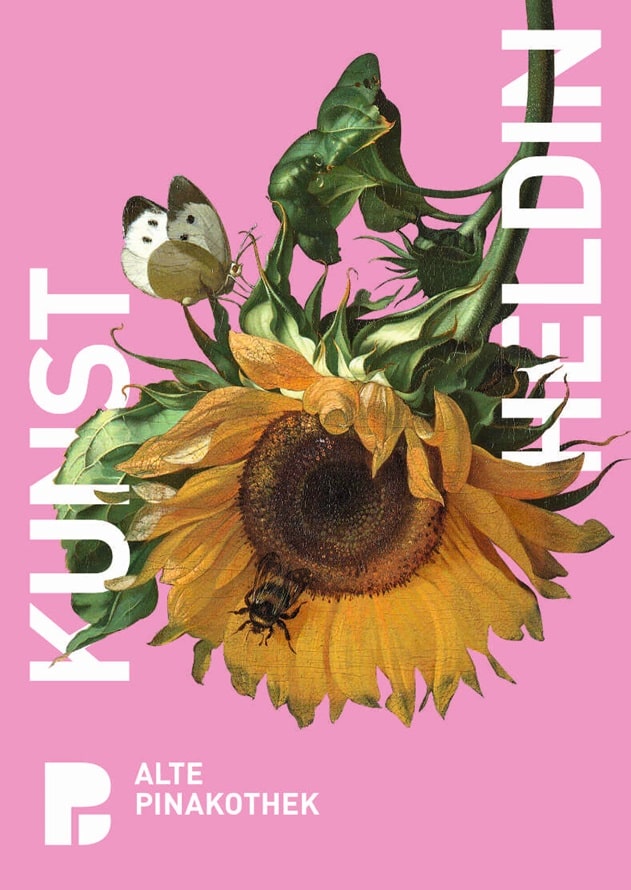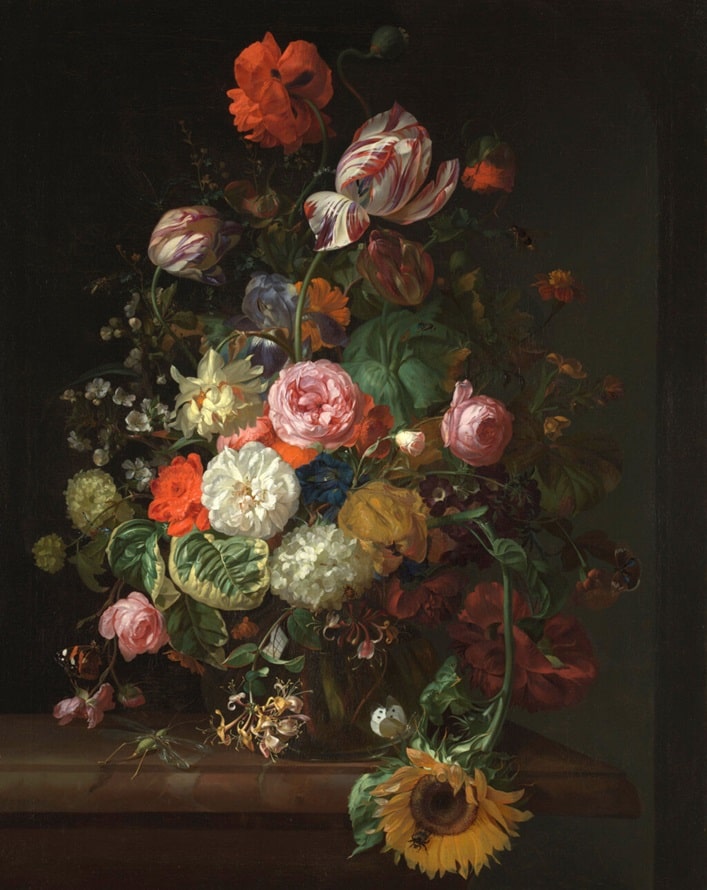The Alte Pinakothek in Munich presents from Tuesday, 26 November 2024 the exhibition Nature into Art by the artist Rachel Ruysch. No other Dutch artist received as much praise during her lifetime as the Amsterdam painter Rachel Ruysch (1664-1750). Her biographer admiringly called her ‘Holland’s artistic marvel’ and ‘our artistic heroine of genius’.
Image above: Rachel Ruysch (1664-1750), Stillleben mit Rosen, Tulpen und Sonnenblume, 1710, oil on canvas, 88,9 × 71,1 cm, Inventarnummer L1317, The National Gallery, London, on loan from the collection of Janice and Brian Capstick © Private Collection
Her magnificent, deceptively realistic floral still lifes with plants and fruit, butterflies and insects from the most diverse regions of the world were already considered sought-after and expensive collector’s items during her lifetime. Demand was so great that the Amsterdam painter could only afford to produce a few paintings a year. As the daughter of the renowned professor of anatomy and botany, Frederik Ruysch, the first female member of the prestigious Hague artists’ fraternity Pictura, court painter to the Wittelsbach Elector Johann Wilhelm von der Pfalz in Düsseldorf, lottery winner and mother of ten children, she was an exceptional figure in her time. Nevertheless, her life and work have not yet been sufficiently researched.
The Alte Pinakothek, the Toledo Museum of Art and the Museum of Fine Arts, Boston are now dedicating the world’s first major retrospective to her, which will open in Munich on 26 November 2024. ‘Rachel Ruysch – Nature into Art’ explores the artist’s life, her long and prolific career and her enduring fame.
With a selection of over 50 of her works from all creative phases, the exhibition will for the first time provide an overview of her approximately seventy-year career, present the diversity of her pictorial themes, reunite separate pairs of paintings and demonstrate the outstanding quality of the artist in the context of her contemporaries.
The focus will also be on the artistic and intellectual environment in which she lived and worked. In particular, the connections between her work and the major scientific issues of the 17th and 18th centuries will be traced. The famous collection of scientific specimens by her father, Frederik Ruysch, is likely to have been a major source of inspiration for her artistic work.

The exhibition thus sheds new light on the connections between art, nature and science at a time of scientific upheaval and on the role of women in the exploration of nature. Rachel Ruysch’s relationship with other renowned still life painters and the tradition of flower painting on which she built are also included. The juxtaposition with paintings by her teacher Willem van Aelst, her contemporaries Jan Davidsz. de Heem, Otto Marseus van Schrieck and Abraham Mignon as well as other talented artists such as her sister Anna Ruysch, Maria van Oosterwijck and Alida Withoos illustrates her influences, her love of experimentation and her innovative strength.
Around 80 paintings from national and international lenders from 14 countries will be presented in the Alte Pinakothek, including 57 paintings by Rachel Ruysch herself, around 41 works on paper, almost 600 zoological and botanical specimens and historical optical instruments. With this wealth of exhibits and the numerous loans from eight state museums and institutions in Bavaria, this exhibition is exceptional for the Alte Pinakothek.
The exhibition is divided into the following five sections:
Section 1: An auspicious beginning
The exhibition opens with the early work of the artist, who worked in Amsterdam. A selection of the most important paintings from the first decades of her career are juxtaposed with works by her teacher Willem van Aelst, other contemporary still life painters such as Jan Davidsz. de Heem and Otto Marseus van Schrieck as well as the leading flower still life painter of the time, Maria van Oosterwijck.
Section 2: The two sisters
Few people know today that Rachel had a younger sister called Anna. She was also a talented painter of floral still lifes, but did not achieve the professional success of her sister. Anna’s life and work have hardly been researched; only around a dozen of her paintings are known today. While the two early careers seem to develop in a similar way, hardly any works by Anna after her marriage are known. In this exhibition, the sisters’ still lifes are presented together for the first time.
Section 3: Art, nature and science
A special focus is placed on Rachel Ruysch’s connection to botanical and zoological research of the time. The role of her father Frederik Ruysch, a renowned scholar and professor of anatomy and botany, who amassed an extensive and widely known collection of natural specimens and made it accessible to the public, is presented. Through her father, Rachel Ruysch had access to the Amsterdam Botanical Gardens, where native and non-native plants that came to Europe as a result of colonial expansion were on display. Artists used the ‘Hortus Botanicus’ as a source, documented imported species and made a significant contribution to the transfer of knowledge.
Section 4: Fame and recognition
The most successful and productive years for Rachel Ruysch followed from 1700. In 1701, she became the first female member of the renowned Pictura artists’ brotherhood in The Hague. She created the brilliant, colourful and deceptively realistic bouquets of flowers with fruit and insects that established her international reputation. In 1708 she was appointed court painter to Elector Johann Wilhelm von der Pfalz in Düsseldorf; she remained in his service until his death in 1716. During this time, she regularly combined magnificent bouquets of flowers with detailed pieces of fruit teeming with insects. The late work from 1735 onwards then surprises with another change in style by the artist: the lush and dense bouquets of flowers now give way to smaller, looser and lighter floral arrangements with hints of French rococo. Visibly proud of both her advanced age and her still confident brushwork, Ruysch added her age to her signature.
Section 5: Change of view
In an educational space specially designed for the Munich exhibition, student projects from the Ludwig-Maximilians-Universität München (Human-Centered Ubiquitous Media), the Hochschule für Fernsehen und Film (CreatiF Centre and Chair of Artificial Intelligence) and Sheffield Hallam University as well as the artist Margarita Berger creatively explore the question: How can Rachel Ruysch’s working method, her selection of motifs and their arrangement in the painting be best understood today? The resulting works, some of which transform Ruysch’s paintings into three-dimensionality, open up new perspectives on the works of the ‘Old Master’ for the public and allow them to experience them in a new way.
WHEN?
Vernissage: Monday, 25 November 2024, 7.00 pm
Exhibition dates: Tuesday, 26 November 2024 – Sunday, 16 March 2025
WHERE?
Alte Pinakothek
Barer Str. 27
80333 München






